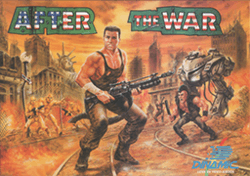After the War (video game)
| After The War | |
|---|---|
 Spanish ZX Spectrum version of After The War's cover art | |
| Developer(s) | Dinamic Software |
| Publisher(s) | Dinamic Software |
| Platform(s) | Amiga, Amstrad CPC, Atari ST, Commodore 64, MS-DOS, MSX, ZX Spectrum, Coin-op |
| Release |
|
| Genre(s) | Action |
| Mode(s) | Single-player |
After The War is a video game published in 1989 by Dinamic Software, in which the player controls a character through a post-apocalyptic city, probably after a nuclear war. Released and unreleased artworks by Luis Royo and Alfonso Azpiri reveals that the city should be a post-nuclear version of New York City.
Gameplay
The game consisted of two separate parts; the second half of the game was made accessible by successfully completing part one, whereupon the player is given a password (94656981).
First part is localized in the streets of the city, and is just a sequence of fights with minor enemies and some big bosses; target is to find the entry to the city underground transport, that is in the opposed part of the map.
Second part is localized in the railways and stations of the city underground transport. Some enemies are bigger than in the first load, and more complex in design.
Character movements were slightly different in both parts: common movements were to move left and right, to jump and to duck. While in first part the only way of fighting is using fists and legs, the second part gives the character the ability to use some kind of futuristic gun. Both loads featured some parts with two levels.
Development
Versions
Some 16-bit versions featured digitized voices. Some ports featured tricky graphical effects (e.g., the Amstrad CPC version included both mode 0 and mode 1 graphics at a time). After The War featured two of the classical “FX” brands of Dinamic, the FX double load (consisting on two separate parts to get advantage of computer memory) and FX giant sprites, that made use of very big sprites that can be even ¾ of the total play area height. Note that those “FX” brands are simply commercial names that Dinamic used to name some features of its games.
The “giant sprites” trick was that sprites were composed by a set of small parts that allowed reusing of those parts in different characters (e.g., a lot of enemies share the same trousers and leg movements). In some ports, a problem with the vertical sync of the monitor lets the player to easily see this trick (sometimes characters got rendered divided in two clearly different slices).
A few computer magazines published notes about a coin-op version of the game that was never released outside Spain, although a coin-op of the game could be played many years ago in the Parque de Atracciones in Madrid, graphically identical to the 16-bit computers counterpart.
Cover art

The cover artwork for After the War was created by artist Luis Royo. At the time development began, Spanish comic book author Alfonso Azpiri was a collaborator with Dinamic for the creation of the box art for their games. Azpiri, whose brother Jorge contributed some of the graphics for the Amstrad CPC version of After the War,[1] drew an initial version of the intended cover artwork for the game. However, due to its protracted development schedule, by the time the game was completed Azpiri had ended his collaboration with Dinamic to work with software company Topo Soft.[2] After the War was then released with new cover art commissioned to Royo.
Legacy
In 2011, years after the dissolution of Dinamic, some of its founding members acquired the rights to distribute the Windows game Collapse in Spain and Italy under their new software company FX Interactive. The game was rebranded as After the War and marketed as belonging to the same fictional universe as the original 1989 game.[3]
References
- ↑ "After The War" (in French). CPC-Power. 2015-02-09. Retrieved 2015-10-13.
- ↑ "Retro: The ten greatest front covers by Alfonso Azpiri" (in Spanish). IGN España. 2013-07-01. Retrieved 2015-09-26.
- ↑ "After the War, the new FX Interactive release, in stores next week" (in Spanish). Vandal. 2011-09-17. Retrieved 2015-09-25.